
Content
| Welcome to the Club of Amsterdam Journal. “Sometimes changes creep up on us. Will humans evolve into cyborgs? Well, if you think about how much you do through your smartphone, and how you rely on it to communicate (without speech, in general), and to make things happen in your life, then perhaps much of the transition to cyborg is already behind us and we just need the final touches to the interface (chip in the brain etc.). And what about the way we interact with the internet to get the goods we want? It is argued here that the internet-based marketplace is evolving (and AI will accelerate this) into a reactive entity where the needs and desires of people actively and rapidly affect what is offered, even what is made. Suggestive of the merging of the human mind (or minds) with computers. It makes one wonder – where do the boundaries lie?” – Paul Holister The Future Now Show: Global Marketplace with Hardy F Schloer “ULTRANOW briefings by Lise Voldeng are advisory bullets traversing every sector of civilization – providing forecasting, analysis and advisory insights on how to prosper integrously. ULTRANOW briefings are brought to you by Ultra-Agent Industries Inc. and UAI CEO Lise Voldeng. UAI is an accelerator. We train individuals to lead themselves, their lives, their organizations, and their countries with joyous, prosperous integrity. We forecast developments across every sector of civilization. We develop product solutions for every sector of civilization. And we invest in, advise, and mentor individuals and organizations.” Felix F Bopp, Founder & Chairman |
Trip to China with Mike Rana – Part II
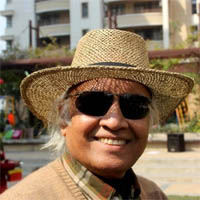
by Mike Rana
Creative Head & Founder, eFingertip, Consultant Social Networking
Mumbai, Maharashtra, India
Dalian – An easy city
Dalian – The populace
Dalian – The forest zoo
Read also in the Club of Amsterdam Journal, June 2017, Issue 195
China – 3 Hops
Dalian Over The Waves
Dalian – The easy city
Dalian competes well with the most glamorous cities of the world. I found it more glittery and flashy than what people told me. Now, after my visit, I know that it’s more captivating and mysterious than whatever they wrote. Does it allure you too to visit Dalian? Probably it does.
I’m sure you’d consult Google before you plan your visit. But maps shouldn’t be your only reference. Goggle maps are dependable but Google itself is blocked in China. Lonely Planet hasn’t published a guide for Dalian. In Dalian, it might take you a few days to lay hands on an English tourist map. If you don’t wanna be disoriented, you better carry some information on printouts or on the pen drive. Otherwise, down the memory lane, after you return, you might continue to miss Dalian, as an enigma.
Does it have history
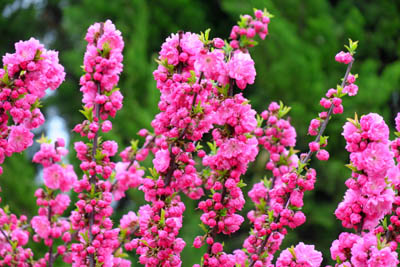
Dalian is unlike the heavily traveled Beijing, Xi’an or Hangzhou. Those cities are dominated by palaces, temples and museums, which emphasize their long history and rich culture. In contrast, Dalian in the Liaoning peninsula, is a dynamic, vibrant and modern city.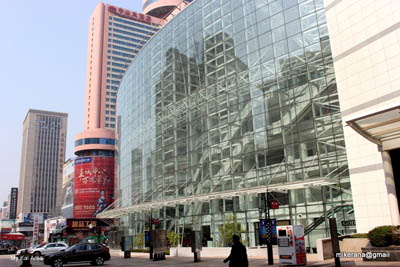

A hundred years back it was just a fishermen’s village, and look where it has reached. It now boasts of a maritime extravaganza, a shipping yard and a locomotive factory. And it has a lot of high rise buildings, parks and eateries. In 2007 February, it was granted the title of “China Best Tourist City” and Google called it “The most livable city in China”.
The first half of these years saw power struggles between Russian, Japanese and Chinese, but now with China becoming a super power, Dalian has its singular status. Being declared a sister city of many similar cities like Vancouver, Vladivostok, Glasgow and others, there is enough potential for Dalian’s further development and tourism. But for me St Petersburg in Russia, should be called its twin city. There are very many reasons for that statement.
Both the cities are ports and Dalian is more befitting as a harbor because the sea water does not freeze here, as in St Petersburg. It remains functional throughout the year.
A related painting at Dalian Museum
Emotionally, the residents in both these cities carry history in their heads. If St Petersburg (erstwhile Leningrad) suffered at the hands of Germans, Dalian’s previous generations also took the onslaught of misery of the struggles for power. If Leningraders get the credit of recovering from the wintry torture of the German seize (more than two years i.e. 1941 until 1943), which took them three generations, I think Dalianites will do it only in two generations.
I’ve personally seen the first generation suffer in Russia and the one-night turmoil that took place when the old Ruble was converted to the new one. I shudder to think of the pensioners when their savings of life time were reduced to rubble overnight. Most of them were unable to buy a pair of shoes from their rainy day funds. It was a government-inflicted poverty, on which no one dared raise voices. How would you feel if you’re in that situation, and overnight at that? I was so moved at their impasse that I framed the old Ruble note, and kept it hanging as a souvenir in my office. It does remind me pitifully, of the so called pensionary funds, which are so fragile in the hands of the governments. I am myself a pensioner.
Dalian too bore the brunt of smaller wars than the World War II, and the suffering on people was no less, – poverty, food shortages, and deaths. Thought, this agony was not emphasized in the world. May be China was hidden behind a metaphorical wall. I empathized and fell in love with these hapless residents in both the cities in my very first visit. I’ve seen them recover, and something tells me that the present generation of vibrant youth, coupled with modern internet facilities and international travels, would probably turn out equal if not better than St Petersburg.
Major Benchmarks in the City
All maps give you a static impression of a city. They show the placement of different benchmarks and if you’re quick-witted, you can memorize them. But it is important that, as a traveler, you grasp a mental picture instead, and do that rather quickly. That mental abstract helps you through the streets and corners of the city in your day to day wanderings. For example, in Delhi you memorize everything with reference to Ring Road, or in Paris Eiffel tower is the relevant vantage point.
There were two such roads that always rang a bell in my mind in Dalian.
Roads and Plazas
One of them, is the Renmin road that extends from the Gangwan square to the Zhongshan square, about 4 KM long. It houses a lot of the high-rise buildings such as the Shangri-La hotel, the New Friendship Store and the like. The road presents a breathtaking view of the modern architecture, and walking on it merges you with the commoners on the street. Beyond the Zhongshan square, it extends to Zhongshan road.
Brand shops at Zhongshan Area
The other one is the Binhai (coastal) road, a stretch of 30 kilometers, that leads you through the sea resorts and beaches of the city. What do you think of a city that has a coastal line of about 1900 kilometers? Not a city; to me it is more like an island. Being on that road a few times, was indeed a pleasure. If you miss this road, then Dalian will remain just another metropolitan city of the lots, in your memories.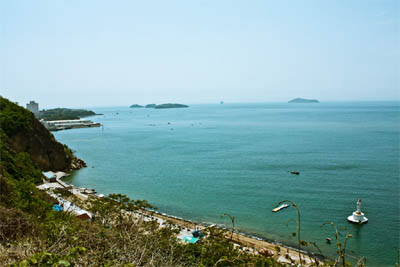
Your entire travel could concentrate on or around just these two roads and you’d have covered half of the city. Most of the plazas or squares for example, Shengli (Victory) Plaza, Olympic Square, Gangwan (Bay Square in English), YouHao (Friendship) square, Xiwang (Hope) square, Renmin (popularly known as Stalin) square, Xinghai (represents the reunion of Hong Kong to mainland China) are all on these roads. Whether you stay for a week or a month, these very names will be reverberating in your mind. You can easily configure the bus routes based on these concepts of squares and radial roads.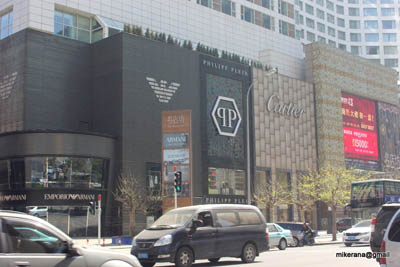
One benchmark which you can’t shut eyes to is the flyover that converts the Jeifang road to Wuhui road. The 5-star Kempinski hotel standing majestically on this turn marks the beginning of the Wuhui street. Whether you pass over it at night or in the day time you’ll simply be overawed by its glamour. If you’re not dazzled by the night illumination pampered by the hotels Meridian, Swish or Parkland, you will certainly be blown away by the gold tinted sea food restaurant which stand shoulder to shoulder to the Meridian. And what to speak of the of array of car headlights at night or when there is downpour. It is simply astounding. You cannot but choose to pass on or around the flyover.
Style and Architecture
The city follows the Paris style layout. Radials roads stretch between each plaza, square or space. Because in modern times such roads are prone to traffic congestion, therefore designers tend to arrange construction in avenues and blocks as in New York, Toronto or Chandigarh in India. So if you take a wrong road you could be drastically diverting from your intended destination, and returning back to the starting point will be the only choice, whether you take or leave it. Historically both the Russians and the Japanese preferred to build Dalian as a regal and majestic city, and they both followed this style. Maybe they didn’t expect such voluminous growth. And now the Chinese are continuing with the same paradigm, only they make them imposing in size.
Zhongshan Square
Bus stops
To say that the roads and public transport infrastructure is excellent, is an understatement. The buses are in abundance and frequency of their plying is countless. The beauty is that multiple routes can be chosen for the same destination. On a major bus stop you’ll find multiple sub-bus stops, each for a different destination. If you know the destination then choose the direct route, but if not as I was in the beginning, you choose any route and you will reach your destination somehow or the other, by indirect routes.
On every sub-bus stop, which may be within a few meters of each other, there is a route chart depicted on beautifully designed displays. They appear neater than a billboard. The only information lacking on these may be the maps or photographs. No commercial ads are vandalizing or defacing their surfaces, as they invariably do in India.
These charts have two sides, on one side is inscribed the route in Chinese and the other side is in English. Every bus-stops in the route appears on these displays and the current stop is highlighted. If you read the display upwards, you get the route in the reverse order (that is all the stops which went past up to this point) and if you read downwards you get the stops that are forthcoming on the way ahead.
So looking at all the displays on the bus-stops, you can determine which bus must be taken for a particular location. You don’t have to ask for help, if you know the name of the place that you wanna visit.
Of course every stop follows a queue and one Yuan is collected from every passenger by the driver, in a box placed for this purpose. No body travels without ticket. And if you make a mistake, get down anywhere and change over to the new route. It is well affordable at 1 Yuan per trip.
Cars and Public Transport
And cars! you name a brand and it is there in Dalian. I found Bentley and Porsche with young girls on wheels. Both sides of the roads and streets were lined up with abundance of cars. Mercedes all models, BMW’s, Volkswagen, Volvo, Toyota and Nissan and almost all form of SUV’s are parked on both the sides. I didn’t fail to notice, and you too will find, that they were brilliantly polished and shining. And what a surprise, sometime the ladies were seen taking up the role in the car care. I’s so excited at the array and brands of cars on display, that a special section for cars and public transports was crafted in my portfolio of photographs.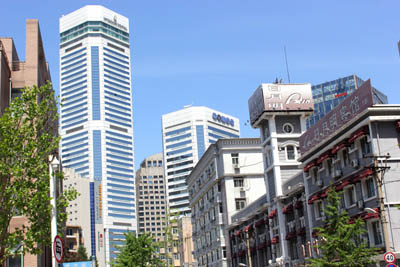
The cars take turns for parking; in day time the office goers park near their offices and they return at night to park close to their residences. Amazing that they find adequate space, and each parking bay is marked with paint or with bricks. I think it is a good arrangement and I wish we followed it in India. There were however excellent parking spaces in the bottom three floors of high rise buildings.
Taxi drivers. they do not cheat as in other countries, probably they don’t find fresh tourists in their day to day operations. Everyone is aware of what price one should be paying for one’strip. The taxi driver is assured of 10 Yuan every trip. So why would he cheat.
There are very little metros in Dalian. Out of the proposed 5 lines only one works for the time being, and I guess they aren’t emphasizing on them. Since the other systems are working without glitches. Some places within the downtown area, are connected with trams. Two types exist; one the classic type – the older version and another the newer type – the modern looking.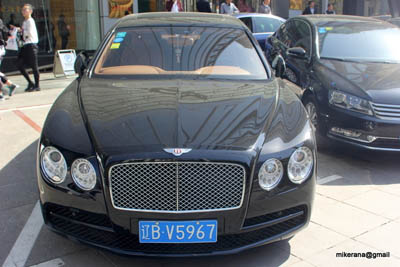
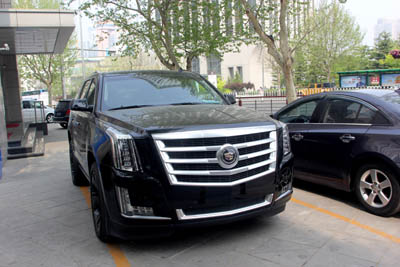
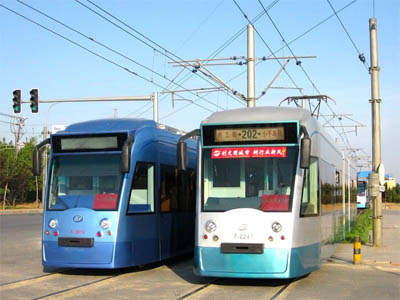
Pricing Euphoria
Yuan is the currency in China. The distinction between the terms renminbi and yuan is similar to that between sterling and pound, which respectively refer to the British currency and its primary unit.
Aren’t you surprised that the one trip on local bus costs only 1 Yuan (about Rs 10) and the taxi fare varies between 10 Yuan to 30 Yuan. The local train fares are similar. Won’t it allure you to be in Dalian, and travel around? It is far too little than in Europe or in America. Are you crazy, the whole of the Dalian city can be traversed in taxi by spending less than 500 Rupees?
Conclusion
If what I described to you is Greek and Latin, or Chinese, you could explore the city yourself and find pleasure in abundance.
Dalian – The populace
Another Day
After a few days of rain, it took a break. A day without drizzle or drops. An ideal one for grocery and fruit shopping. People turned out in large numbers. The array of drench coats or wind-cheaters was probably tucked up in their messenger bags. And their shoes wore a decent sight. They were carefree about the drizzle but were equipped for a downpour.
I decided to take a day off from my driving to do some solitary roaming. The humidity was restrained, the winds tolerable and the sun coolly bright. Nataliya had thought of an umbrella for me which found a convenient place in a shoulder pouch, that I was carrying every time I stepped out. It was the smartest article in my inventory of travel gear and took care of any impulse buying that I was vulnerable to. And when I walked out, my jeans blended me in the crowds.
I carried a makeshift map which I’d purchased on the roadside yesterday. It had a serious handicap. It was in Chinese. It made no head nor tail to me. I couldn’t even hold it straight in the right direction. But Nataliya had marked a glaring bold spot on it, big as life, that indicated where I must return at the end of the day. It wasn’t for me but for a benevolent soul whoever wanted to help me. It came in very handy with the taxi fellows.
My exit from the apartment was welcomed by children who were kicking up their heels along with their dog in the garden. The dog and the tiny tots were almost identical in size. They looked lovely. They smiled, even their dog. Were they expecting a Ne Hao from me? Sure they were, but I simply clicked a photograph in return.
My walk wasn’t a slow stroll but it had pace in it, like an average Chinese. They all walked briskly unlike most of us in India. We tend to crawl even in an emergency, that is what we are. They bear with the traffic signals whereas we try to guide them instead. The only abhorrence that I found was that some of them spoke aloud even when they talked normally. Perhaps it was in their language.
In a couple of minutes, I came to a spot where the road divided into two. On the left was the downtown which I’d no intention of walking early in the morning, so I took the right side. Again I reached a crossing in about 5 minutes, and my gut feel told me that the area on the left was promising. It was either the Renyi or the Nashan Jie. It did not matter so I wheeled left and pressed on.
As anticipated the down-slope led me to a smallish plaza with an imposing building on the left and a smaller glamorous one on the right. The left was a hospital and the right was a language school.
English School
An impulse thronged me towards the school. Two adjoining buildings had impressive exteriors and they looked great. In an alien country, the sight of the three familiar words “Century English School”, were inviting. It was not a school like schools per se, but was a house which used its large compound and was extremely well decorated. Sure it could attract students. For me, it was almost an ultimate hangout for a foreigner.
There were not many people inside, as I learnt later, it was closed for some holidays. I was greeted by a smartly dressed receptionist but I failed to speak even Ne Hao, I had still not mastered the accent. I was in a bit of quandary about what my inquiry should be.
She took the initiative and asked me if I want to teach (Jiao) or learn (Xuéxí), she used the following construct “Do you want to learn English or teach”
“Ni xiang xuéxí yingyu huò jiào”?
These words ‘teach and learn’ are the two of the difficult words to understand for a foreigner. For example, I still get confused when I have to use these words in Russian.
“Whether I should say “Ochit for learn” or “Ochat for teach”
I simply took for granted that confusion was prevailing and I said “yes yes.”
The smile was her best bet, and she used it very aptly. She left her seat and went inside to seek help. I used this time for scanning the room and the photos that were displayed. There were as many as six instructors on them. They all appeared to me expatriates from England or Canada. A few minutes later an immaculately dressed man appeared and he asked,
“How can I help you, Sir”?
The six words that he spoke were enough to let me know that his English was perfect. I did not think he was a Chinese or if he was, he was well brought up in English. I was a bit nervous about my Indian accent but I knew that when it came to grammar I would beat him hollow. I asked without hesitation,
“Could I take up an assignment for teaching, here”? my accentuated English accent was clear in my speech.
He was a bit surprised since he assumed me to be just a tourist or a migrant and wanting to learn Chinese. I noticed that the receptionist was smiling, I don’t know whether she underrated my English or she was intrigued that I wanted to learn Chinese.
“Right now our school is closed for vacations and its Principal is away to Beijing. You must speak to her. She will return on 6 of May”.
This was bit encouraging, because he did not reject me outright. Perhaps there was shortage of an English teacher and perhaps he thought my personality was enough for the students. I returned his admiration by saying, “Oh Yes I will. I like this building”.
He was all smiles as he bid me farewell. He did not forget to remind me again, “Maria would return in the first week”.
Later I saw some other schools that taught foreign languages and had the option of teaching Chinese as well. And they were all very well laid out. Before I left I thought of asking him if there was a worthy place in the vicinity for a tourist.
“Yes of course. We have an exquisite children’s park right down the lane. You may like to walk up to the next crossing and then take a right turn”.
This was my time to thank him and the girl. My quest for exploration continued. I had the hospital to visit first.
Hospitals
There is a lot to be said about the hospitals and nursing homes. But equal dilemma exists about which system of medicine’s the best to administer. Like the Greek, the Chinese alternate systems compete well with the Indian Ayurveda systems. The most important attribute may perhaps be the cost associated when life and death is not in question. Thanks to Google, I’ve seen very senior doctors surfing the net to search for the right medicine.
Exactly the same dilemma came to my mind when I saw the two hospitals in Dalian. Looking at the pictures I was tempted by the traditional medication provided by the second hospital. That appeared more glamorous and two receptionists were positioned right at the entry to ease patients. But not many Chinese go into hospitals. Is it because they’re healthier than I had imagined or they have alternate systems of medicines. The age does not show on their faces and they do not limp while walking.
A Chinese Traditional Hospital
Park Entry
During my sojourn in Dalian of a month, parks and flowers were not on my priority in the beginning but they assumed significance rather quickly. I could not avoid them on the roads, plazas, squares, or corporate offices. They were spine-tingling, hair-razing or simply out of the ordinary. When the teacher at the school advised me to visit the park, I probed its validity by referring it to the map in my pocket. The “Children Park” was no doubt shown on the map but it was rather a smaller green compared to the other greens on the map. But I was quite near the spot and it was the right benchmark to be made on the map. So might as well venture into it.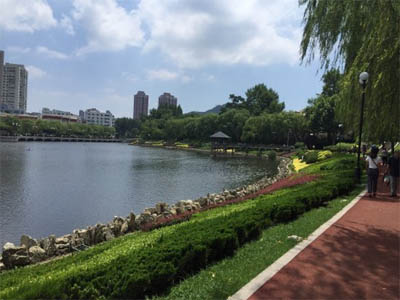
I entered the park with a stereotype in mind. The overcrowded and unkempt parks in India flashed my mind. Or will it be like the sparsely populated forests in Russia. But the name encouraged me, “Children’s Park”. I speculated it to be not too bad. In fact, it deserved the name as “Children’s and Elder’s Park”, because at this time almost equal number of children and elders were present in that park.
Artificial Flowers
In a country where flowers are in abundance, seeing the use of artificial flowers or bushes was quite a stunner. I found them in flower arrangements where they were used in a mix with real flowers, or as standalone bushes in the larger spaces as in parks or in the condominiums. Quite innovative, I thought. And the Chinese cutting-edge technology in gardening was that they moved large number of flower pots prepared in a nursery for deployment on the traffic islands or isles.
The approach to the park featured the back side of a modern building on the left and a collection of Sakura and Lilac trees on the right. Far at a distance, I could see a gathering of people of all ages. In the near vicinity, young women were taking photographs. It was a sight of happy families.
Children Assembly Hall
I was intrigued with the building on the left so I decided, first I must see what it was. It was an assembly hall of some kind. From its large windows I saw that children were entering or exiting the hallway. They were watched over by parents.
I compared them with the children in India. In India, irrespective of the richness of the parents, children fail to get an appreciation of the “value of money”. They indulge in expensive mobiles, shopping at the malls, cars if the parents can afford, and in activities that the parents will not ultimately approve. Outdoor life is missing for most of the youth in India. In China until a few years ago when only one child was allowed, the parents took excessive care of their children. They inculcated in them dignity of labor and value of money. I was seeing a proof of that intention, here.
Calligraphy
What fascinated me the most in that building was a middle-aged man teaching the art and science of calligraphy to the children. Including the others, I was captivated by his skills. The vertical holding of the pen and the way he dipped the dip pen in the ink dazzled us more than the script that sprawled by his side.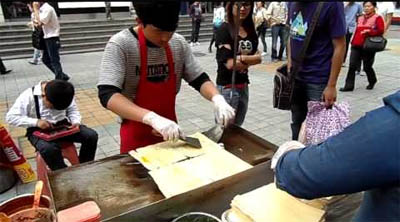
The shape, size, stretch and type of hair in the brush, the color and density of the ink, as well as the absorptive speed and surface texture of the paper are the main physical parameters influencing the result. The calligrapher also influences the result by the quantity of ink/water he lets the brush take up, then by the pressure, inclination, and direction he gives to the brush, producing thinner or bolder strokes, and smooth or toothed borders.
According to Stanley-Baker, “Calligraphy is sheer life experienced through energy in motion that is registered as traces on silk or paper, with time and rhythm in shifting space its main ingredients.” Calligraphy has led to the development of many forms of art in China, including seal carving, ornate paperweights, and ink stones.
When I was young, and still had control over fingers and hand muscles, they all called me a calligraphist. I used to write certificates because of the imperial style that was popular in our time and we wrote using a z nib or a relief nib using holders. I think it was more to do with my good handwriting. But my dream for calligraphy was renewed after seeing how it should actually be done. So my calligraphy dream remains a dream until I return back to China.
Park Continue
I returned to my main excursion and chose walking lazily so that I could click pictures. People’s behavior was on top of my agenda. Some of them were strolling and others preferred to walk briskly. Three girls were busy in taking shots, not selfies. It was the first time on this trip that I saw anyone wearing the famous Japanese cap with extended shade for the eyes. Other girls preferred flats over the stilettos even though they were bereft of heights. And the elders preferred sitting around tables, playing games or simply chatting. They were dressed in different costumes but one item was predominately used, the cap. Children were being escorted by mothers dragging their perambulators.
It was a park with lush green grass all over the place. And this grass was natural unlike the artificial grass that is trended in many shopping malls of the world. The park was laid with concrete pathways and these were enclosed by bright lovely white balustrade. If you continued on the pathways, you could complete the full circle, but I decided to take a diversion. I passed by the side of a building where all action was taking place. People were learning to dance, dogs were being escorted, people sprawled themselves on tables and chairs, children played and so on.
From here I was led into the main area in the park, that had a large lake with the backdrop of the buildings in this part of the city. It was not really a spectacle like the panorama described in another article, but it was no less. Have a look at it.
While on the peripheral road of the lake, which was paved in red, I met an interesting character. He simply walked into me making me nervous about what his intentions were. He smiled and wished me in English. It was the greatest boon manifested in this people’s garden with interesting people, all engaged in their own affairs. So far, the only communication between me and them was smiles. Occasionally it was interrupted by the click of the camera shutter.
But this changed for the better now. The prospects of talking opened up as this gentleman told me that he was learning English and that he wanted to go to America.
“Do you need any help from me in your learning”, I thought why would he otherwise be speaking to me.
“No I just want to speak in English and talking to you gives me a good person to person practice”.
Sounds were coming closer from two women who continuously engaged in giggling and clicking photographs. We both were interrupted and they requested us for taking some joint pictures for them. Their target was me, because they probably saw the open camera lens that I was carrying. This man took up the assignment as a professional translator, repeating in two languages whatever transpired between us. He enjoyed the exercise. Of course, I had to correct him at times.
Progressively our friendship developed and they offered me a casserole to eat. I hesitated and made it known that I was a vegetarian. This man helped me to resolve the issue. They decided that a chocolate cookie was a better and safer offer. I’ll never know whether their offer was a formality, a reward for my services or they actually wanted to show friendship. Their smiles and giggles though were natural.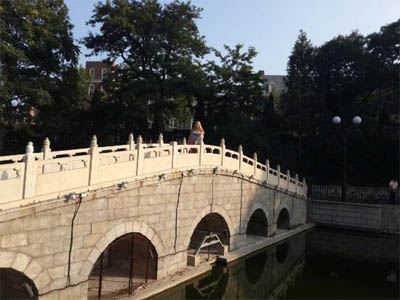
Hairstylists on roadside
Looking at my watch, I realized that spending three hours was just adequate for this exotic place and I must move on. I arrived near the exit gate, and from a distance, did I see a silhouette of hairstylists on the roadside? Yes, I did.
Impulsively I was drawn towards them. Finding them a bit like India where such roadside saloons are common. We see them in different towns, and even big cities. They are called colloquially “Ita-Saloons”, implying that they deploy a looking-glass which rests on a pair of bricks. In China, where the hair-styling art is a technology in itself, finding such saloon on the roadside was hilarious, to say the least.
The Roadside Hair Styling
Also, I thought China was an equal country and it lacked class difference. How then it supported this concept of poor-rich divide? The question still remained, who do these saloons cater for? Or was it only the older people who oblige the poor but skillful hairstylist; he does not even need a mirror! This certainly put me in a bit of quandary.
I saw these people happy enjoying their chat, may be they discussed the golden English sentence that everyone speaks in China, “Long Live Chairman Mao”.
Japanese Colony
With a heavy heart I moved away from the park. Surprisingly the gate where I left, was a bit lonesome too. Was it already missing me and my clicks? In spite of the luxuriously cover of the weeping willows and rose bushes, it presented a gloomy portrayal. I was on the road now, and a lonesome walk took me to a Japanese street. It was equally desolate. Buildings of low-rise structures, quite elegant and different from the normal Dalian. Not many people lived here, but some entrepreneur found it right to have an imposing and opulent pub-cum-bar.
In that state of mind, I mean somberness and melancholy, that I suddenly found myself in, there could be nothing more gratifying than being smiled at by two lovely women, understandably mother and daughter. They were kind of adjusting their dresses and posing for selfie or something. They saw me coming over and they almost jumped with joy and asked me to photograph with them or at least take a snap or two of them. This is what I term as friendliness with strangers, they had no fears and no inhibition. I of course took a few snaps on their selfie but I was not happy unless my Canon worked on these models. They were more than pleased to pose for me and I clicked them.
A day well spent
At the end, when I look back at the children’s park, it was really a treat. I went to this place a few times during my stay. I found here that real life was not devastated by the mobile phones or virtual chats. And I found here that there was less class distinction. Why don’t the Chinese add it to the tourist map more glaringly?
Dalian – The forest zoo
Dalian – An Inimitable Zoo
I am not an ardent admirer of zoos, and I haven’t been to many. But wherever I had been, namely, Wien, St Louis, Chandigarh Delhi, Mysore, Calcutta, they sparked my soul. Yet I cannot but relate myself to the incomparable Dalian Zoo, when my mind was dazed by the behavior of people and the animals in it. Never did I imagine that there was such a lot of resident love for the animals in the otherwise branded aggressive Chinese. I felt I was part of them all. And you must admire me for not failing to notice younger people mixing and talking to animals not just to the favorite Pandas and Monkeys but Lions and Bears. Hats off to the people, animals and above all the government for creating such a fantastic facility in the city.

My trip to the zoo was, to put it with a pun, an accidental one. Sun Yu Jiao, was the name of the girl who met me on the galaxy of bus stops in the downtown. She knew not even a word of English and I didn’t know a word of Chinese from Adams. Looking at my expressions like an imbecile running from one bus to another looking for the route number she told me, made her to laugh out loud. Believe me there were more busses on the countless adjoining stops in the downtown area than the travelers. I was admiring the buses and comparing them to the under-maintained Delhi Transport Buses with jealousy, forgetting that I was lucky to be boarding one of them, soon.
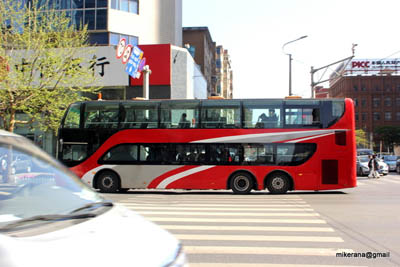
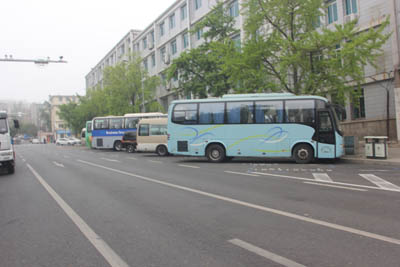
She came back to me and asked me if I needed her help for the bus exploration. And why not, how could a lonely traveler lost in the woods, refuse such a fine offer. But more surprising was she could join me for the trip to the Zoo. I doubted if she would be charging me for the service, but then I thought it could not cost more than a day time escort service. So, I decided to hire her, without knowing the damage she will inflict on my pocket. And she spent good five hours with me.
Soon, I realized she wasn’t a guide or an escort but a college girl. How did I come to know about it? Again, by accident, she took me to the far end of the zoo instead of the entry end. Some co-passengers too fell into that trap. The bus route was wrong. Neither she, nor the two-honeymooning couples had bothered to check. Any way we all embarrassingly got down and took another bus that ultimately dropped us at the entry of the zoo. At what cost, unimaginable one Yuan that equals ten rupees or six dollar cents. Traveling on public transport is really cheap in China.
Of course, I paid for the entry, that was steep. This is how the wrong entry looked like.
This is how the real entry gate looked like. It was amazingly pleasant and a lot of children around.
Some amazing aerial views inside the zoo, captivated me, and I am sure they will have the same effect on you …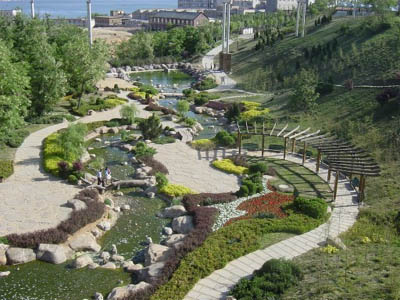
Inside the zoo, where we spent four hours, she didn’t take even a glass of water that I had benignly offered her along with a cold drink. She said an absolute NO, and I was embarrassed drinking the water in my possession …
The exit and drive back was on my own, but we exchanged email addresses on the WeChat platform, remember Gmail does not work in China. This small travelogue is dedicated to her … I wonder if ever she will read it …
Countries – put pressure on the United Nations!

by Christer Nylander
Lund, Sweden
Terrorist attacks are a daily activity on the planet and it is increasingly difficult to stop them. Climate change mitigation is far slower than needed. Robots will soon create mass unemployment. Biodiversity is endangered all over the planet. Growing flows of refugees generate fear, conflicts and extreme political views. These are only the tip of a huge iceberg of global systemic risks that seriously threaten our civilization and the planet. Most people feel that the current times we live in are quite good. It may appear so to a few billon people but the truth is horrifyingly apparent. You can ask almost anybody in high positions in the global community and you will find frustration, desperation and even resignation. This is not a good sign!
I am fully convinced that it is high time that we begin to reflect on the situation on much deeper levels than we usually do. For example, ask yourself, is it possible to have hundreds of different types of problems in society that permeate every corner of this planet, without having a global systemic error? What I mean is, are all problems separate or are the connected? Today we act as if they are separate. Humankind has a strong tendency to focus on laws, regulations, incentives, surveillance, taxes, etcetera, to govern our society. This does not make much of a difference. Despite thousands of international organizations, and tens of millions of people actively involved in social issues around the world, the success of developing a resilient and sustainable planet has been meager. This should tell us something important. We are thinking and acting inside the box, from where all the problems derive. Instead, we should start thinking outside the box.
Here follows my own deep reflection! The outer world we experience will always be a mirror of our inner world. What do I mean by that? First, try to think about a planet without people. Obviously, all the present problems are gone. Thus, logic tells us that humans are both the problem and the solution. Our ability to foresee, understand and act in a way that is long-term and beneficial for all involved will always decide the fate of this civilization. This ability can be called wisdom and I will describe it in more detail here below. Before entering this complex subject I would like to mention a contrary opinion. Some people would argue that it is society that is affecting humans, implying that we ought to start changing our society in order to change the minds and actions of people. So, who is right? Well, if we analyze the last argument there are at least two vital insights. The first is that humanity is already trying to do that and obviously failing. The second is, if the citizens of the world are a product of its society our fate is sealed, i.e. there is no way out of the precarious state of affairs on the planet – we can not change a society which controls us. This is called a Catch-22 situation and is apparently a dead end. Thus, it is better that we truly believe that it is possible to upgrade our knowledge, insights and inner abilities in order to collectively govern our society and the planet.
So, what is wisdom? According to Wikipedia wisdom is the ability to think and act using knowledge, experience, understanding, common sense, and insight. Thus, there is a big difference between intelligence, knowledge and wisdom. I say this because some people can not separate them. But, how do you develop wisdom? Here the subject gets really confused. Even though there are tens of thousands of books describing how to develop certain abilities to handle stress, enjoy your life, be healthy, increase memory, deal with conflicts, develop leadership skills, etcetera, there is surprisingly little research and few books on how to develop wisdom in a more general sense. Or, is it really that strange that there is so little material on the subject? Probably not. If humanity could better understand the concept of wisdom, and there was a lot of research and literature on the subject, I would not have had to write this article. After reading a lot of literature from many different faculties, I began to contemplate on what kind of ingredients that are crucial for the development of the kind of wisdom that our civilization is in such desperate need of. This said, we should remember that even if wisdom is often seen as a general human quality, it is to a large degree context based. Being the president of the United States or an ordinary citizen requires wisdom, but not the same kind of wisdom.
So what ingredients make the perfect soup of wisdom? I found nine inner abilities/qualities that are more significant than others. The first deals with positive social values and virtues. These are vital because they are the guiding principles of life. They transcend specific actions and situations and serve as standards or criteria. Every social value and virtue is interpreted differently by different people around the planet, but the process of developing positive social values and virtues increases the ability to take wise decisions. The second comprises the ability to understand wholeness of self, others, groups, society, nature and systems. We need to make it a habit to place every fragment into the bigger picture and clarify its roles, impacts, consequences, inter-dependencies, etcetera. The third is about leadership capacity of oneself, a team, an organization, or a nation, and includes motivation, understanding the mind, coaching, handling uncertainty, creating internal and extra stability, etcetera. The fourth deals with creativity and problem solving capability, and is characterized by the ability to perceive things in new ways, to find hidden patterns, to make connections between seemingly unrelated phenomena, and to generate new ideas. The fifth is about critical thinking, which means the intellectually disciplined process of actively and skillfully conceptualizing, applying, analyzing, synthesizing, and evaluating information generated by observation, experience, reflection, reasoning, or communication, as a guide to belief and action. The sixth involves emotional references. In order to understand other people’s feelings we have to have our own similar emotional references derived from life experiences, books, films, music, games and much more. These are important conditions for empathy. The seventh is about practical skills that are needed to understand how things work in real life so as to be able to assist in various assignments, manage our own life, create resilience and sustainability, and to be creative and problem solving. The eight includes theoretical knowledge, which is necessary to comprehend the world around us, including physical objects, concepts and ideas, our history, human interaction, etcetera. The ninth deals with conflict resolution abilities, and embraces the methods and processes involved in facilitating the peaceful ending of conflict and retribution.
Some of you might wonder if it is necessary that everyone on the planet must develop their wisdom. Would it not be easier if just a few, for example politicians, put work into developing their wisdom? Unfortunately, this is not how it works. Why? Because ordinary people are voters, consumers, corporate leaders, politicians, investors, journalists, educators, experts, researchers, etcetera. None of us are unimportant. If the wisdom level of the citizens of the world is low, politicians can easily deceive them with populistic promises. Lack of wisdom leads to bad decisions. On the contrary, if all people are reasonably wise, the decisions made will probably be sound and lead to a more stable society, and social problem would decrease considerably.
So how do we turn mentioned ingredients into wisdom? This is a more complex part that needs elaboration and examples. In general it involves education, training, practice, dialogue, and a lot of reflection. Usually life itself offers possibilities for these and there are some indications that higher wisdom comes with age. The challenge for humanity is that it must rapidly develop context based wisdom to cope with the global, national, regional and local issues that it faces. In practice one teacher is needed for each individual, on a daily basis, to help us. Here is where artificial intelligence (AI) becomes really interesting. The aim is not that AI should tell us what we should do, but to help us, for example, with education, training, monitoring, services and reflection. At the end of the day, it will only be conscious reflection and unconscious processes that enhance our wisdom, i.e. how we translate knowledge, training, dialogue, etcetera, into abilities that help us to foresee, understand and act wisely. I would like to stress the importance of the described inner development process, because there are many people who believe in and work to augment human abilities through implants, drugs, gene manipulation, body extension, etcetera. Humanity must deeply contemplate what this means for us as humans and for future generations. It is all too easy to play with novel technologies as soon as they are developed, because they are facinating and a source for huge economic profits. However, this is not wise. When AI assists all of us in various natural ways we are still the same humans, but with enhancement techniques we become something different. This changes our personality and identity, and to be able to afford techniques that enhance intelligence, memory, health, strength, vision, and prolong life, wealth suddenly becomes significantly more important. This issue can hardly be overstated since the gap between the rich and poor would grow even more dangerous and serious ethical considerations on who would have access to these techniques would have to be on the agenda. Needless to say, either all people on this planet are included in the game, playing according to the same rules, conditions and benefits, or there will be no game at all. We do not have to be prophets to understand this simple truth. If you are still not convinced about the need for more wisdom, think about the reality we have to face when billions of people are left behind economically and technologically, using weapons of mass destruction and bioweapons, or engage in cyberterrorism or even mass invasion. Today’s terror attacks would be minor incidents in comparison.
So, how do we design and finance a whole system of tools that works on a global scale and that would provide everything we need for everyone to become wiser? Before describing it, I would like to point out some requirements that the system must fulfill. It has to be easy and interesting to use, be applicable to all kinds of human contexts and be integrated in daily activities. It must include all tools necessary for individual feedback, education, cooperation, communication, seminars, training, sharing, consultative voting, apps, inter-mediation of experts, donations and crowd-funding, mentoring, statistics, cultural events, and furthermore school activities and computer games related to the sustainable development goals (SDGs). It must be integrated with eGovernment, eHealth and eBank, and everyone must have a digital identity. It must be free of charge and be voluntary, and furthermore, it is imperative that it is not used for indoctrination.
In order to visualize what a day could look like and to understand the profound impact such as a system will have, one example is described below. This instance may be a few years ahead when the maturity of AI and augmented (AR) / virtual reality (VR) has attained a somewhat more advanced level. At breakfast I chat with my avatar and tell it that I am having a meeting before lunch about a design of a new agroforestry food system for a certain city and that I am meeting Mr X, Mrs Y etcetera. I explain some of the challenges in a simple way. The avatar gives me some samples of other designs that have recently been implemented, as well as some articles related to the subject. The avatar provides information about the participants of the meeting, and perhaps some articles or lectures they have been part of. The avatar interprets the challenges of the meeting and asks me if I have thought about certain important social values and norms that I seem to have had problems with earlier in similar situations. The avatar goes through all the nine drivers of change to help me prepare for and optimize the meeting. After lunch I look at a 10 minute presentation in my AR/VR headset showing a new innovation that turns sea water into fresh water that a university would like to crowd-fund. Later I decide to give 100 dollars to the project, and I also participate in a consultative voting related to a public transport initiative that the avatar showed me a few days earlier. I tell my avatar to send off a few emails and book a time for a group AR/VR meeting next month. When I come home I attend a virtual online course in how to grow vegetables under tree canopies. Before going to sleep I give a summary of the day to my avatar, which gives me a short feedback and encouragement. The next day could be quite different. I could, for example, go on a AR/VR tour to Australia to see how the barrier-reefs are recovering. Another possibility could be that I am part of an expert group discussing a new type of house construction where people from all over the world could meet in a beautiful VR office located on a mountain hill. The avatar might recommend me to take more part in the local agroforestry food production since I have felt more stressed than usual the past couple of weeks. I can give my avatar permission to see my bank account and mobile applications, and use them to give me helpful feedback. For another person the experience could be quite different and interaction with the system could vary during the day. However, nobody can avoid reflecting over the nine drivers of change and SDGs, on a daily basis. As AI becomes more advanced so will more complex communication and feedback.
The most cost-efficient way of providing everyone with these services is if, for example, the United Nations became the global hub for this with full responsibility for the system. In this way the costs could be shared among many countries. In my proposal I have named this hub Drivers of Change Platform (DOCP), because the nine abilities necessary for augmenting wisdom will be the drivers of change. An obvious counterargument would be that billions of people still do not have access to internet, or have slow connections, which do not permit them to participate. I agree. That is why I propose that 5G bandwidth, smartphones, AR/VR headsets, accessible battery charging and a digital identity should be guaranteed to all people on the planet. This will of course cost a lot. Probably more than one trillion dollars. Is it worth it? Yes, if we can avoid a global collapse of our civilization, a few trillion dollars is a very low price.
But who would pay and why, and how would the financing be achieved? The rich countries possess a lot of technology and know-how that developing countries need. It will be the rich countries that will suffer the most if our civilization crashes. Thus, the incentive to assist developing countries ought to be in the rich countries. At the moment the wealthy nations are experiencing slow growth rates, which means that they have excess production capacity. So, how should this financing be achieved? There is, in fact, already a good method that is not yet being used. The central banks could buy government bonds, which is called overt monetary policy, and make the aid a form of unconditional countertrade to finance both the DOCP and the SDGs. This method would likely incentivize many potential donor countries due to the positive effects on the GDP, in contrary to pooling, which extracts financing capital from rich countries, and decreases their GDP. Are there any drawbacks? Hardly any. One possible drawback, however, could be that donor countries have to secure a reasonably low inflation by managing demand and supply. But, since climate change requires that rich countries decrease their consumption, the risk for inflation will be low. In contrary, increased export to developing countries will counteract a likely deflation.
If properly designed and implemented, mass education of people, and the daily use of the DOCP, could begin within the next five to ten years. After that, the benefits of this system would grow each year. Some of these benefits would be a drop in population growth, reduced crime and terrorism, improved global governance, a reduced sectarian divide and an improved capacity to deal with climate change. Further, the capacity to build a sustainable and resilient state of the art infrastructure, industry and food production in developing countries. This is worth stressing, since any other outcome would be a global failure.
How fast can we develop wisdom? The easy answer is that we do not know. It will depend on how much humanity invests in the necessary tools, the attractiveness of the user platform and on the individual conditions of nations and their citizens. I am convinced that the first steps on the wisdom ladder could be achieved quite quickly, maybe within a few decades. This general level of wisdom would be sufficient to successfully govern the planet. More advanced wisdom would require increasingly longer time to attain. Obviously, this is not a problem, because enhancing wisdom can be an ongoing activity for thousands of years.
Let me summarize. With the DOCP it is feasible to upgrade the inner drivers of change in every human whatever their conditions or starting level, and simultaneously respect equal value of all human beings. When upgrading inner drivers of change, the decision-making ability of policymakers will gradually increase, and the political support from the population will grow, as will the capacity for self-governing. The model permits a high level of democracy, making it possible for citizens to influence, on a daily basis, local, regional, national and global issues. This will ensure that decisions are taken as closely as possible with the citizens, in accordance with the principle of subsidiarity, which most certainly will minimize crippling delays. The suggested DOCP model can probably be accepted by most of the UN members since it is a win-win game. Huge cost-savings can be made if all citizens on the planet speak English, either as first or second language, and many positive side-effects would be achievable related to conflicts, communication, education, R&D, documentation, translation, media coverage, and trade. The DOCP would also facilitate retraining of the global workforce enabling people to easier take up new occupations because of new technology and changed consumer demand. Furthermore, the DOCP will enable people that live in rural areas to participate in the global workforce, to obtain all kinds of education, and to enjoy the same cultural variety as people in the urban areas. This would mean a slower urbanization or even a reversed trend, and a prospering countryside. The proposed governance model generates trust and transparency by upgrading the ability of billions of people to foresee, understand, and act in a way that is beneficial for all involved. The DOCP model is highly flexible in that: a) the platform can easily develop and change, and is at its core an evolving model for change b) upgrading drivers of change and inner development is an individual task and experience, making it possible to respect different human contexts c) countries develop their own laws, measures and regulations depending on their country-specific conditions to reach the SDGs, thereby keeping their sovereignty d) the cosmopolitan democracy model can grow from infancy to maturity e) not all countries have to join in at the start f) the transformation speed will be maximized in each country, depending on how fast the inner drivers of change are upgraded and g) there is ample scope for testing new DOCP modules in different countries or regions before making them standards.
So what should be done to realize the DOCP? I believe that both developing and developed countries should put this proposal, and similar ones, on the global agenda in the United Nations to create pressure. The whole proposal can be downloaded here.
The Future Now Show
Every month we roam through current events, discoveries, and challenges – sparking discussion about the connection between today and the futures we’re making – and what we need, from strategy to vision – to make the best ones.
Shape the future now, where near-future impact counts and visions and strategies for preferred futures start.
Do we rise above global challenges? Or do we succumb to them? The Future Now Show explores how we can shape our future now – where near-future impact counts. We showcase strategies and solutions that create futures that work.
Every month we roam through current events, discoveries, and challenges – sparking discussion about the connection between today and the futures we’re making – and what we need, from strategy to vision – to make the best ones.
Juli / August 2017
with
Hardy F Schloer
moderated by
Mustafa Chaudhry
with
Sometimes changes creep up on us. Will humans evolve into cyborgs? Well, if you think about how much you do through your smartphone, and how you rely on it to communicate (without speech, in general), and to make things happen in your life, then perhaps much of the transition to cyborg is already behind us and we just need the final touches to the interface (chip in the brain etc.). And what about the way we interact with the internet to get the goods we want? It is argued here that the internet-based marketplace is evolving (and AI will accelerate this) into a reactive entity where the needs and desires of people actively and rapidly affect what is offered, even what is made. Suggestive of the merging of the human mind (or minds) with computers. It makes one wonder – where do the boundaries lie? . – Paul Holister
July / August 2017
Unbelievable Intelligence of Plants

What has now begun to be discovered is that the mycorrhizal fungi don’t surround just one tree. By using radioactive trace elements, the researchers were able to show that nutrients were being passed by the fungi between different species of trees over a large area. The trees that were not so good in the winter, like aspens, were being given food manufactured by the conifers, which do much better in winter, and vice versa. So the fungus is actually helping to distribute food amongst forest trees so that they all benefit at the right time. – National Geographic
The automatic assumption that plants are victims, incapable of learning how to cope with new conditions, is an insult and runs contrary to the new evidence. – National Geographic
Plant perception is the ability of plants to sense and respond to the environment to adjust their morphology, physiology, and phenotype accordingly. Other disciplines such as plant physiology, ecology and molecular biology are used to assess this ability. Plants react to chemicals, gravity, light, moisture, infections, temperature, oxygen and carbon dioxide concentrations, parasite infestation, disease, physical disruption, sound, and touch. – Wikipedia
News about the Future
Palgrave Studies of Sustainable Business in Africa
In partnership with the World Association for Sustainable Development (WASD), The Palgrave Studies of Sustainable Business in Africa series aims to provide a global perspective and understanding of international business as a context for sustainable business practices in Africa. Providing new methodologies through which goods and services are produced and managed using sustainable business practices in Africa, books in this series offer a sound grounding in the terminology of sustainable business. In doing so, the series develops a number of tools of analysis in order to conceptualize various business and management theories that can be used to address the challenges posed to the development of African businesses. Adopting and adapting western business and management theories, it will provide a practical application of various theoretical and practical frameworks in order to develop new ways of doing business in Africa. Including case studies, ground-breaking research and new conceptual approaches, the Palgrave Studies of Sustainable Business in Africa series includes contributions from a range of African scholars and leaders of major African academic and research institutions, as well as scholars from around the world. The merging of these perspectives examines how the future of African business and management should be shaped in order to better address the needs of African business development both now, and for future generations.

New EU Commission transport modernisation initiatives
Nowadays, mobility has a massive bearing on the daily lives of European citizens, as well as being a sector that employs over 11 million people. Yet it is experiencing economic, technological, and social changes at an ever accelerating pace.
Recognising this and its potential impact on the European Union (EU) and its citizens, the European Commission recently revealed a broad set of new initiatives, entitled “Europe on the Move”, whose aim is to bring about a socially fair transition towards clean, competitive and connected mobility.
The Block Research Group
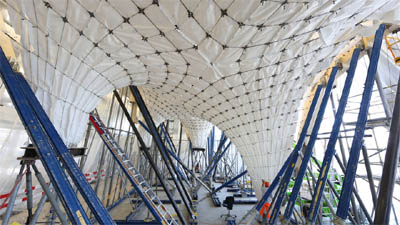
The Block Research Group (BRG) at the Institute of Technology in Architecture at ETH Zurich is led by Prof. Dr. Philippe Block and Dr. Tom Van Mele. Research at the BRG focuses on several core areas, including analysis of masonry structures, graphical analysis and design methods, computational form finding and structural design, discrete element assemblies, and fabrication and construction technologies. The central goals of our geometry-based approach are to understand the real demands of complex structural design and engineering problems and to develop new algorithms and efficient, accessible tools for structurally informed design.
Learning from the past to design a better future
Throughout history, master builders have discovered expressive forms through the constraints of economy, efficiency and elegance, not in spite of them. We have much to learn from their architectural and structural principles, their design and analysis methods, and their construction logics. Inspired by master builders and learning from the past, the BRG aims to provide appropriate assessment strategies for architectural heritage, develop novel structural design approaches for highly efficient and expressive structural form, and propose and implement new and economical construction paradigms.
Research topics
Analysis of masonry structures
Much of our architectural, cultural and structural heritage consists of unreinforced masonry. These historic structures fail mostly due to instabilities caused by large deformations and displacements. The standard structural analysis tools used in engineering practice today are not well suited to deal with these types of structural problems, not in the least because of the unknowable material properties of historic masonry constructions. The BRG develops a robust computational basis for a fully three-dimensional method for limit analysis of vaulted masonry structures with complex geometry. In addition to computational methods, the BRG also studies masonry structures by means of scaled models. Collapse mechanisms can be simulated using an actuated testing table, an optical registration system, and 3D-printed scale models. Learn more.
Graphical analysis and design methods
The BRG develops structural design, form finding and analysis methods, such as three-dimensional graphic statics, that rely on geometrical rather than analytical or numerical representations of the relation between “form and forces” in a structural system. Such explicit approaches provide continuous, bi-directional control over both spatial and structural characteristics in a common visual language that is equally accessible to architects and engineers and therefore extremely useful during early shape and equilibrium explorations.
Computational form finding and structural design
The BRG has developed a computational framework that contains several flexible data structures, novel and efficient solving algorithms, and numerous nonlinear optimization and solving procedures. This allows us to develop new (hybrid) solving strategies for equilibrium problems, often significantly improving solving times and robustness compared to existing approaches. Ultimately the computational methods developed have led to novel structural typologies and structural design approaches for highly efficient, expressive forms. They have enabled the extension of our expertise in compression-only problems to other structural systems, such as thin concrete shells, “bending-active” membrane structures, fabric formwork systems, and general spatial systems of forces with applications in bridge design and large-span roofs.
Design of discrete assemblies
Discrete-element assemblies are structures formed by individual units. These range from structures consisting of relatively small units, such as historical masonry structures, to contemporary large-scale assemblies composed of prefabricated, multi-material building parts or entire building units. Favouring no-tension connections, this research extends and develops novel digital design and engineering approaches that address structurally informed discretization (digital stereotomy), stability during and after assembly, and structural optimization of discrete-element assemblies.
Fabrication and construction technologies
The objective of this research is to develop and implement new, economical construction techniques for structural systems with complex geometries. We propose and instigate new paradigms for structurally informed, optimised building processes in architecture as well as innovative structural design strategies that utilise bespoke fabrication. We seek to define mechanisms to intelligently and efficiently include structural performance information explicitly into architectural geometry and digital fabrication algorithms. Imposing structurally informed constraints allows for more holistic design processes that do not detach formal design from limitations on cost, construction, longevity or structural properties of the chosen material systems.
Part of the National Centre of Competence in Research (NCCR) in Digital Fabrication, the BRG develops structurally informed, optimised building processes in structural design and innovative solutions in prefabrication.
Recommended Book

Brilliant Green
by Stefano Mancuso and Alessandra Viola
Are plants intelligent? Can they solve problems, communicate, and navigate their surroundings? Or are they passive, incapable of independent action or social behavior? Philosophers and scientists have pondered these questions since ancient Greece, most often concluding that plants are unthinking and inert: they are too silent, too sedentary — just too different from us. Yet discoveries over the past fifty years have challenged these ideas, shedding new light on the extraordinary capabilities and complex interior lives of plants.
In Brilliant Green, Stefano Mancuso, a leading scientist and founder of the field of plant neurobiology, presents a new paradigm in our understanding of the vegetal world. Combining a historical perspective with the latest in plant science, Mancuso argues that, due to cultural prejudices and human arrogance, we continue to underestimate plants. In fact, they process information, sleep, remember, and signal to one another — showing that, far from passive machines, plants are intelligent and aware. Through a survey of plant capabilities from sight and touch to communication, Mancuso challenges our notion of intelligence, presenting a vision of plant life that is more sophisticated than most imagine.
Plants have much to teach us, from network building to innovations in robotics and man-made materials — but only if we understand more about how they live. Part botany lesson, part manifesto, Brilliant Green is an engaging and passionate examination of the inner workings of the plant kingdom
Autonomous Rail Rapid Transit
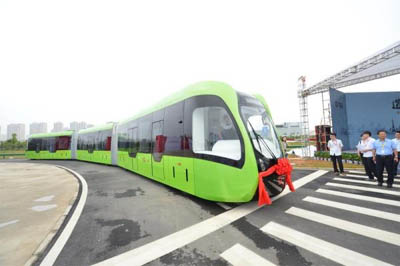
Chinese railcar-maker CRRC on Jun. 2 unveiled a new product called Autonomous Rail Transit (ART) in Zhuzhou, Hunan province, and the bus-rail combo rapid transit system is expected to speed up city’s public transportation.
According to CRRC, ART uses rubber wheels on a plastic core instead of steel wheels. It’s also equipped with the company’s copyrighted technology to automatically guide the vehicles. It carries the advantages of both rail and bus transit systems and is agile and non-polluting, Thepaper.cn reported.
ART is much cheaper than ordinary subway, which cost about 400-700 million RMB per kilometer in China. And compared with electric streetcars, which cost 150-200 million RMB per Kilometer, ART is only about one-fifth the investment.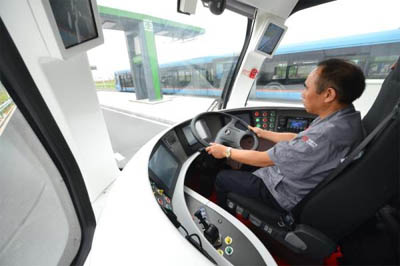
CRRC began designing the ART system in 2013. The first ART car is 31 meters in length, with a maximum passenger load of 307 people or 48 tons. Its top speed is 70 kilometers per hour, and it can travel 25 kilometers in distance after 10 minutes of charging.
The world’s first ART line will be launched in Zhuzhou, with a total length of 6.5 kilometers. Upon completion, it will be able to dock with the city’s mid-low speed maglev train.
ULTRANOW BRIEFINGS: TRUE POWER
ULTRANOW BRIEFINGS
ULTRANOW briefings are advisory bullets traversing every sector of civilization – providing forecasting, analysis and advisory insights on how to prosper integrously.
ULTRANOW briefings are brought to you by Ultra-Agent Industries Inc. and UAI CEO Lise Voldeng. UAI is an accelerator. We train individuals to lead themselves, their lives, their organizations, and their countries with joyous, prosperous integrity. We forecast developments across every sector of civilization. We develop product solutions for every sector of civilization. And we invest in, advise, and mentor individuals and organizations.
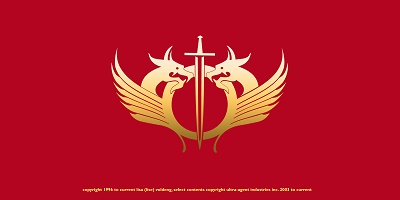
www.ultraagentindustries.com
ULTRA-AGENT INDUSTRIES INC.
[ worldbuilder luxe. for warrior worldbuilders. ]
shows:
ULTRANOW ICECREAM BRIEFING: ON THE JOYOUS BEAUTY OF RIDING ABOVE FEAR
Insight courtesy of UAI CEO Lise Voldeng. Title credits music courtesy of UAI CEO Lise Voldeng and Elad Marish. Supported by the Club of Amsterdam
ULTRANOW letter BRIEFING: a letter to earth, ON THE TRUE BEAUTY OF STANDING TRUE
Insight courtesy of UAI CEO Lise Voldeng. Title credits music courtesy of UAI CEO Lise Voldeng and Elad Marish. Supported by the Club of Amsterdam
Lisa (Lise) Voldeng: CEO, creator, futurist, and investor. Runs accelerator Ultra-Agent Industries Inc. Loves icecream and integrity.
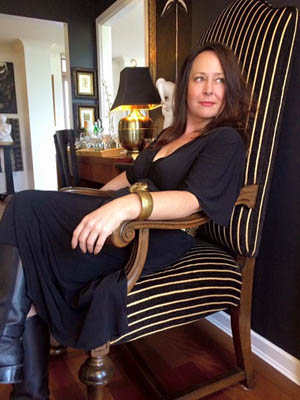
Voldeng consistently successfully forecasts global developments (across every sector of civilization), and consistently successfully develops solutions (across every sector of civilization) to help us prosper. She builds brands, markets, organizations, platforms, products, and experiences. And she invests in, advises, and mentors individuals and organizations who want to prosper integrously.
Futurist Portrait: Jane McGonigal
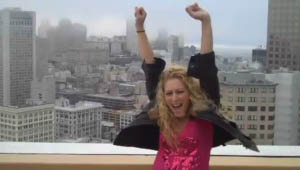
Jane McGonigal, PhD is a world-renowned designer of alternate reality games — or, games that are designed to improve real lives and solve real problems.
She is the New York Times bestselling author of Reality is Broken: Why Games Make Us Better and How They Can Change the World (Penguin Press, 2011) — and is the inventor and co-founder of SuperBetter, a game that has helped nearly half a million players tackle real-life health challenges such as depression, anxiety, chronic pain, and traumatic brain injury.
Jane is also a future forecaster. She is the Director of Games Research & Development at the Institute for the Future, a non-profit research group in Palo Alto, California. Her research focuses on how games are transforming the way we lead our real lives, and how they can be used to increase our resilience and well-being. Her future forecasting work has been featured in The Economist, Vanity Fair, The New Yorker, O(prah) Magazine, Fast Company, The New York Times Science section, and more.
She is the founder of Gameful, “a secret headquarters for worldchanging game developers.”
She has a PhD from the University of California at Berkeley in performance studies, and has consulted and developed internal game workshops for more than a dozen Fortune 500 and Global 500 Companies, including Intel, Nike, Disney, McDonalds, Accenture, Microsoft, and Nintendo. Before joining IFTF, she taught game design and game theory at UC Berkeley and the San Francisco Art Institute.
She currently serves on the Board of Directors for Games for Change.
“My #1 goal in life is to see a game designer nominated for a Nobel Peace Prize. I’ve forecast that this will happen by the year 2023. Of course, it’s not enough to just forecast the future — I’m also actively working to make it a reality. (And you can too — join Gameful, the Secret HQ for Worldchanging Game Developers.) My best effort so far? SuperBetter, a game that has helped nearly half a million players so far tackle real-life health challenges like depression, anxiety, chronic pain and traumatic brain injury. (See the successful results of University of Pennsyvlania’s randomized controlled trial of SuperBetter for depression, and learn more about our NIH-funded clinical trial of SuperBetter for rehabiliation.)
In the meanwhile, on the way to that epic win, there are plenty of other achievements to be earned.”
How to Think (and Learn) Like a Futurist, now!







Customer Reviews
Thanks for submitting your comment!